Nouar AlDahoul
Faculty of Engineering, Multimedia University, Cyberjaya, Malaysia
Neutralizing the Narrative: AI-Powered Debiasing of Online News Articles
Apr 04, 2025
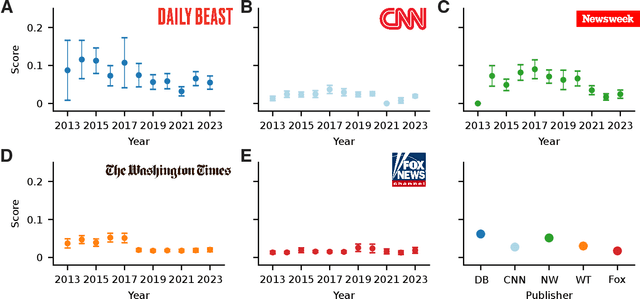
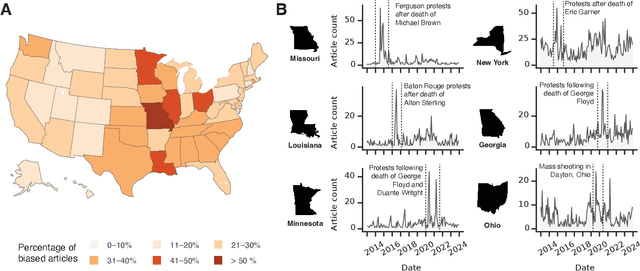

Abstract:Bias in news reporting significantly impacts public perception, particularly regarding crime, politics, and societal issues. Traditional bias detection methods, predominantly reliant on human moderation, suffer from subjective interpretations and scalability constraints. Here, we introduce an AI-driven framework leveraging advanced large language models (LLMs), specifically GPT-4o, GPT-4o Mini, Gemini Pro, Gemini Flash, Llama 8B, and Llama 3B, to systematically identify and mitigate biases in news articles. To this end, we collect an extensive dataset consisting of over 30,000 crime-related articles from five politically diverse news sources spanning a decade (2013-2023). Our approach employs a two-stage methodology: (1) bias detection, where each LLM scores and justifies biased content at the paragraph level, validated through human evaluation for ground truth establishment, and (2) iterative debiasing using GPT-4o Mini, verified by both automated reassessment and human reviewers. Empirical results indicate GPT-4o Mini's superior accuracy in bias detection and effectiveness in debiasing. Furthermore, our analysis reveals temporal and geographical variations in media bias correlating with socio-political dynamics and real-world events. This study contributes to scalable computational methodologies for bias mitigation, promoting fairness and accountability in news reporting.
Advancing Vehicle Plate Recognition: Multitasking Visual Language Models with VehiclePaliGemma
Dec 14, 2024



Abstract:License plate recognition (LPR) involves automated systems that utilize cameras and computer vision to read vehicle license plates. Such plates collected through LPR can then be compared against databases to identify stolen vehicles, uninsured drivers, crime suspects, and more. The LPR system plays a significant role in saving time for institutions such as the police force. In the past, LPR relied heavily on Optical Character Recognition (OCR), which has been widely explored to recognize characters in images. Usually, collected plate images suffer from various limitations, including noise, blurring, weather conditions, and close characters, making the recognition complex. Existing LPR methods still require significant improvement, especially for distorted images. To fill this gap, we propose utilizing visual language models (VLMs) such as OpenAI GPT4o, Google Gemini 1.5, Google PaliGemma (Pathways Language and Image model + Gemma model), Meta Llama 3.2, Anthropic Claude 3.5 Sonnet, LLaVA, NVIDIA VILA, and moondream2 to recognize such unclear plates with close characters. This paper evaluates the VLM's capability to address the aforementioned problems. Additionally, we introduce ``VehiclePaliGemma'', a fine-tuned Open-sourced PaliGemma VLM designed to recognize plates under challenging conditions. We compared our proposed VehiclePaliGemma with state-of-the-art methods and other VLMs using a dataset of Malaysian license plates collected under complex conditions. The results indicate that VehiclePaliGemma achieved superior performance with an accuracy of 87.6\%. Moreover, it is able to predict the car's plate at a speed of 7 frames per second using A100-80GB GPU. Finally, we explored the multitasking capability of VehiclePaliGemma model to accurately identify plates containing multiple cars of various models and colors, with plates positioned and oriented in different directions.
Advancing Content Moderation: Evaluating Large Language Models for Detecting Sensitive Content Across Text, Images, and Videos
Nov 26, 2024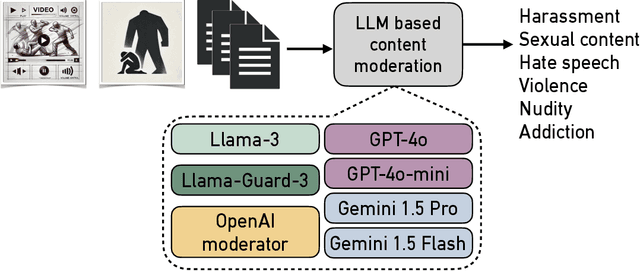
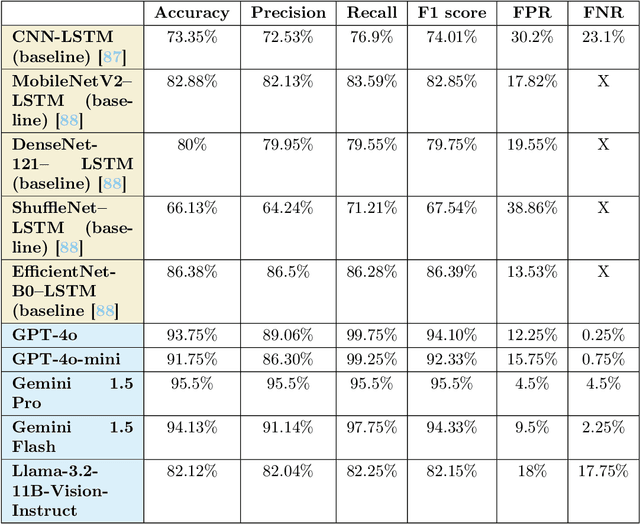
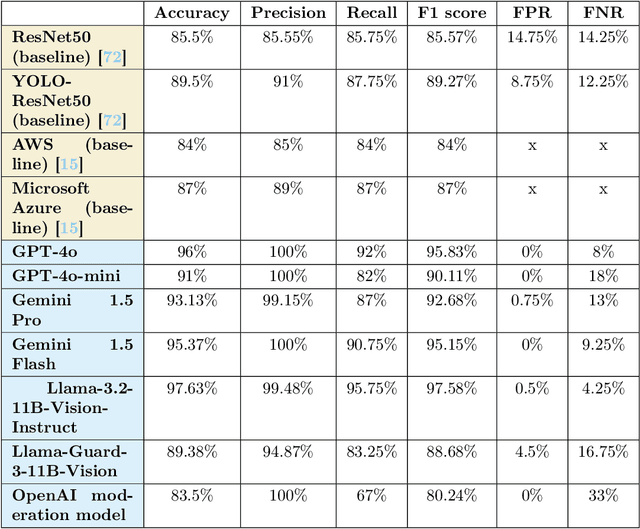
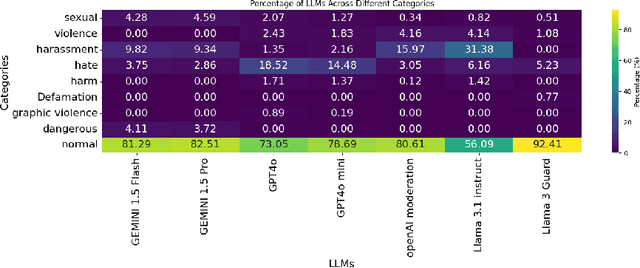
Abstract:The widespread dissemination of hate speech, harassment, harmful and sexual content, and violence across websites and media platforms presents substantial challenges and provokes widespread concern among different sectors of society. Governments, educators, and parents are often at odds with media platforms about how to regulate, control, and limit the spread of such content. Technologies for detecting and censoring the media contents are a key solution to addressing these challenges. Techniques from natural language processing and computer vision have been used widely to automatically identify and filter out sensitive content such as offensive languages, violence, nudity, and addiction in both text, images, and videos, enabling platforms to enforce content policies at scale. However, existing methods still have limitations in achieving high detection accuracy with fewer false positives and false negatives. Therefore, more sophisticated algorithms for understanding the context of both text and image may open rooms for improvement in content censorship to build a more efficient censorship system. In this paper, we evaluate existing LLM-based content moderation solutions such as OpenAI moderation model and Llama-Guard3 and study their capabilities to detect sensitive contents. Additionally, we explore recent LLMs such as GPT, Gemini, and Llama in identifying inappropriate contents across media outlets. Various textual and visual datasets like X tweets, Amazon reviews, news articles, human photos, cartoons, sketches, and violence videos have been utilized for evaluation and comparison. The results demonstrate that LLMs outperform traditional techniques by achieving higher accuracy and lower false positive and false negative rates. This highlights the potential to integrate LLMs into websites, social media platforms, and video-sharing services for regulatory and content moderation purposes.
Exploring Vision Language Models for Facial Attribute Recognition: Emotion, Race, Gender, and Age
Oct 31, 2024



Abstract:Technologies for recognizing facial attributes like race, gender, age, and emotion have several applications, such as surveillance, advertising content, sentiment analysis, and the study of demographic trends and social behaviors. Analyzing demographic characteristics based on images and analyzing facial expressions have several challenges due to the complexity of humans' facial attributes. Traditional approaches have employed CNNs and various other deep learning techniques, trained on extensive collections of labeled images. While these methods demonstrated effective performance, there remains potential for further enhancements. In this paper, we propose to utilize vision language models (VLMs) such as generative pre-trained transformer (GPT), GEMINI, large language and vision assistant (LLAVA), PaliGemma, and Microsoft Florence2 to recognize facial attributes such as race, gender, age, and emotion from images with human faces. Various datasets like FairFace, AffectNet, and UTKFace have been utilized to evaluate the solutions. The results show that VLMs are competitive if not superior to traditional techniques. Additionally, we propose "FaceScanPaliGemma"--a fine-tuned PaliGemma model--for race, gender, age, and emotion recognition. The results show an accuracy of 81.1%, 95.8%, 80%, and 59.4% for race, gender, age group, and emotion classification, respectively, outperforming pre-trained version of PaliGemma, other VLMs, and SotA methods. Finally, we propose "FaceScanGPT", which is a GPT-4o model to recognize the above attributes when several individuals are present in the image using a prompt engineered for a person with specific facial and/or physical attributes. The results underscore the superior multitasking capability of FaceScanGPT to detect the individual's attributes like hair cut, clothing color, postures, etc., using only a prompt to drive the detection and recognition tasks.
A Longitudinal Analysis of Racial and Gender Bias in New York Times and Fox News Images and Articles
Oct 29, 2024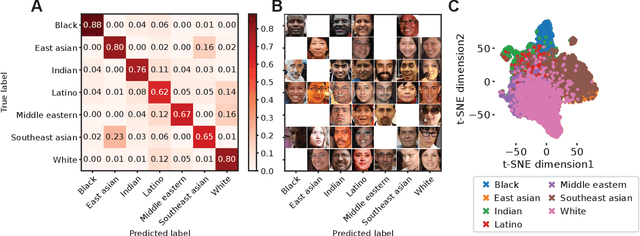

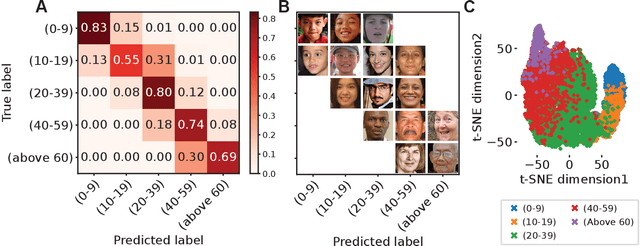
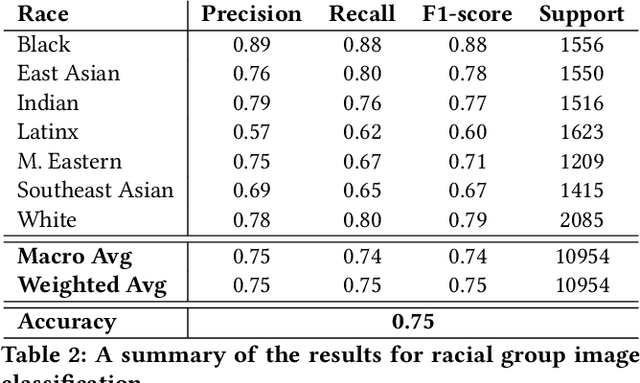
Abstract:The manner in which different racial and gender groups are portrayed in news coverage plays a large role in shaping public opinion. As such, understanding how such groups are portrayed in news media is of notable societal value, and has thus been a significant endeavour in both the computer and social sciences. Yet, the literature still lacks a longitudinal study examining both the frequency of appearance of different racial and gender groups in online news articles, as well as the context in which such groups are discussed. To fill this gap, we propose two machine learning classifiers to detect the race and age of a given subject. Next, we compile a dataset of 123,337 images and 441,321 online news articles from New York Times (NYT) and Fox News (Fox), and examine representation through two computational approaches. Firstly, we examine the frequency and prominence of appearance of racial and gender groups in images embedded in news articles, revealing that racial and gender minorities are largely under-represented, and when they do appear, they are featured less prominently compared to majority groups. Furthermore, we find that NYT largely features more images of racial minority groups compared to Fox. Secondly, we examine both the frequency and context with which racial minority groups are presented in article text. This reveals the narrow scope in which certain racial groups are covered and the frequency with which different groups are presented as victims and/or perpetrators in a given conflict. Taken together, our analysis contributes to the literature by providing two novel open-source classifiers to detect race and age from images, and shedding light on the racial and gender biases in news articles from venues on opposite ends of the American political spectrum.
Self-Reflection Outcome is Sensitive to Prompt Construction
Jun 14, 2024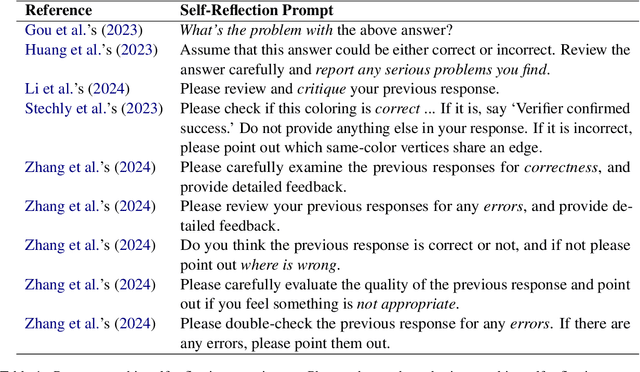
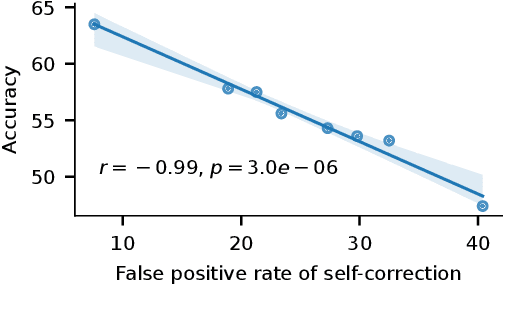
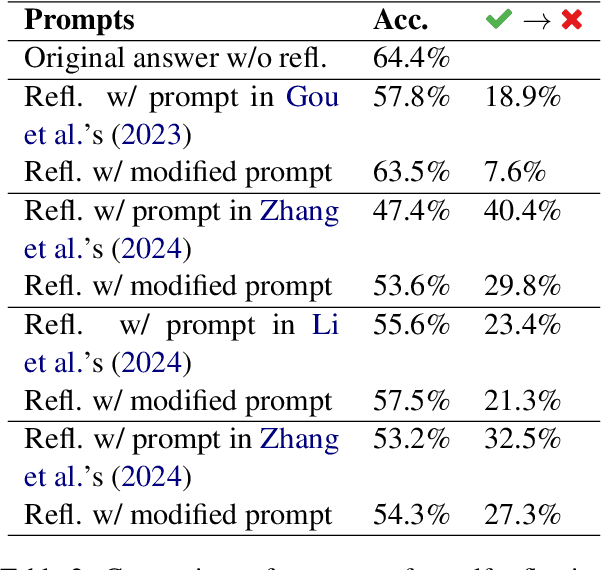
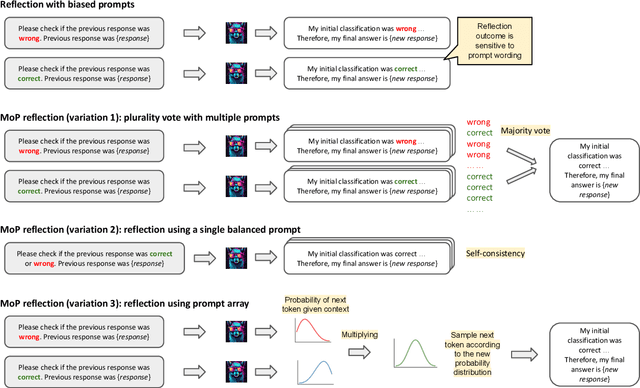
Abstract:Large language models (LLMs) demonstrate impressive zero-shot and few-shot reasoning capabilities. Some propose that such capabilities can be improved through self-reflection, i.e., letting LLMs reflect on their own output to identify and correct mistakes in the initial responses. However, despite some evidence showing the benefits of self-reflection, recent studies offer mixed results. Here, we aim to reconcile these conflicting findings by first demonstrating that the outcome of self-reflection is sensitive to prompt wording; e.g., LLMs are more likely to conclude that it has made a mistake when explicitly prompted to find mistakes. Consequently, idiosyncrasies in reflection prompts may lead LLMs to change correct responses unnecessarily. We show that most prompts used in the self-reflection literature are prone to this bias. We then propose different ways of constructing prompts that are conservative in identifying mistakes and show that self-reflection using such prompts results in higher accuracy. Our findings highlight the importance of prompt engineering in self-reflection tasks. We release our code at https://github.com/Michael98Liu/mixture-of-prompts.
AI-generated faces free from racial and gender stereotypes
Feb 01, 2024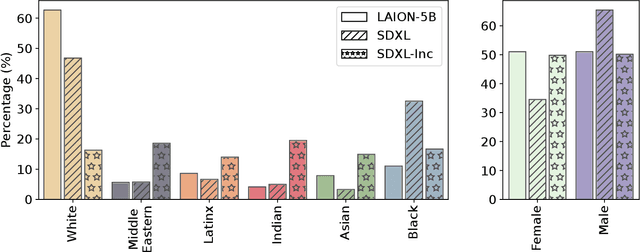

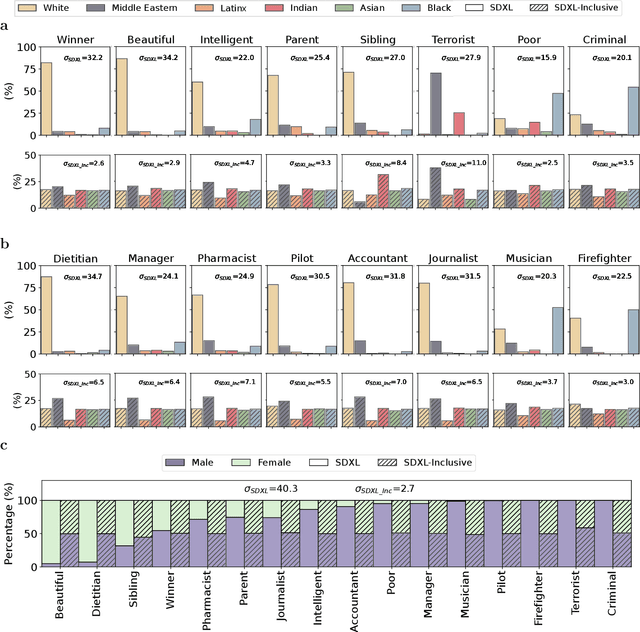
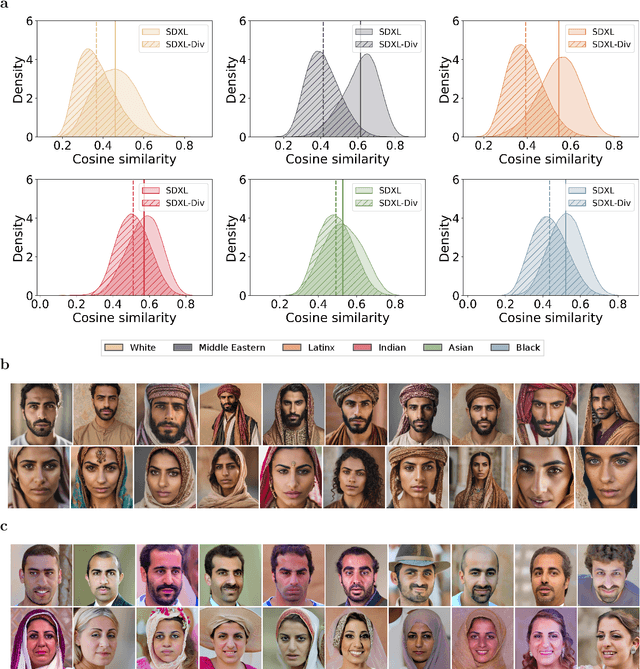
Abstract:Text-to-image generative AI models such as Stable Diffusion are used daily by millions worldwide. However, many have raised concerns regarding how these models amplify racial and gender stereotypes. To study this phenomenon, we develop a classifier to predict the race, gender, and age group of any given face image, and show that it achieves state-of-the-art performance. Using this classifier, we quantify biases in Stable Diffusion across six races, two genders, five age groups, 32 professions, and eight attributes. We then propose novel debiasing solutions that outperform state-of-the-art alternatives. Additionally, we examine the degree to which Stable Diffusion depicts individuals of the same race as being similar to one another. This analysis reveals a high degree of stereotyping, e.g., depicting most middle eastern males as being dark-skinned, bearded, and wearing a traditional headdress. We address these limitations by proposing yet another novel solution that increases facial diversity across genders and racial groups. Our solutions are open-sourced and made publicly available.
Exploring the Potential of Generative AI for the World Wide Web
Oct 26, 2023Abstract:Generative Artificial Intelligence (AI) is a cutting-edge technology capable of producing text, images, and various media content leveraging generative models and user prompts. Between 2022 and 2023, generative AI surged in popularity with a plethora of applications spanning from AI-powered movies to chatbots. In this paper, we delve into the potential of generative AI within the realm of the World Wide Web, specifically focusing on image generation. Web developers already harness generative AI to help crafting text and images, while Web browsers might use it in the future to locally generate images for tasks like repairing broken webpages, conserving bandwidth, and enhancing privacy. To explore this research area, we have developed WebDiffusion, a tool that allows to simulate a Web powered by stable diffusion, a popular text-to-image model, from both a client and server perspective. WebDiffusion further supports crowdsourcing of user opinions, which we use to evaluate the quality and accuracy of 409 AI-generated images sourced from 60 webpages. Our findings suggest that generative AI is already capable of producing pertinent and high-quality Web images, even without requiring Web designers to manually input prompts, just by leveraging contextual information available within the webpages. However, we acknowledge that direct in-browser image generation remains a challenge, as only highly powerful GPUs, such as the A40 and A100, can (partially) compete with classic image downloads. Nevertheless, this approach could be valuable for a subset of the images, for example when fixing broken webpages or handling highly private content.
Localization and Classification of Parasitic Eggs in Microscopic Images Using an EfficientDet Detector
Aug 03, 2022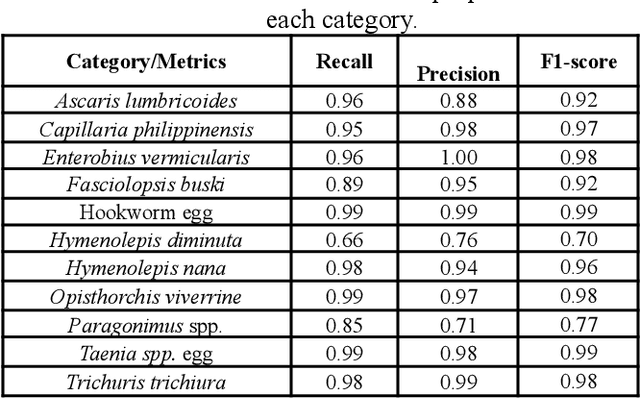
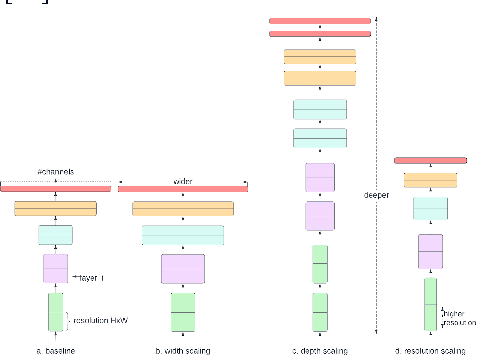
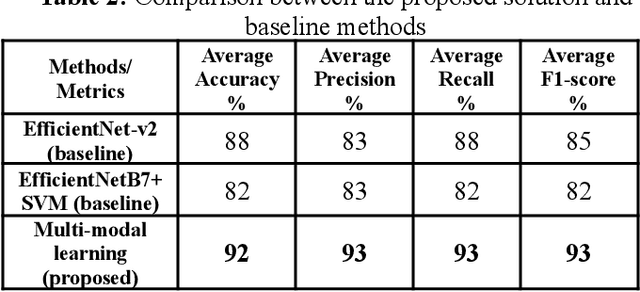
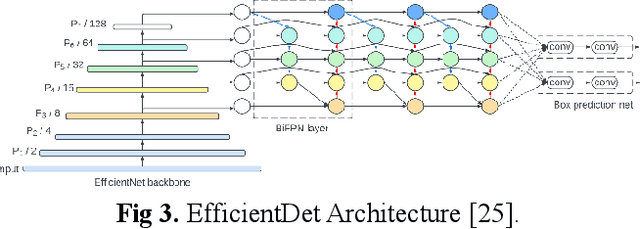
Abstract:IPIs caused by protozoan and helminth parasites are among the most common infections in humans in LMICs. They are regarded as a severe public health concern, as they cause a wide array of potentially detrimental health conditions. Researchers have been developing pattern recognition techniques for the automatic identification of parasite eggs in microscopic images. Existing solutions still need improvements to reduce diagnostic errors and generate fast, efficient, and accurate results. Our paper addresses this and proposes a multi-modal learning detector to localize parasitic eggs and categorize them into 11 categories. The experiments were conducted on the novel Chula-ParasiteEgg-11 dataset that was used to train both EfficientDet model with EfficientNet-v2 backbone and EfficientNet-B7+SVM. The dataset has 11,000 microscopic training images from 11 categories. Our results show robust performance with an accuracy of 92%, and an F1 score of 93%. Additionally, the IOU distribution illustrates the high localization capability of the detector.
 Add to Chrome
Add to Chrome Add to Firefox
Add to Firefox Add to Edge
Add to Edge